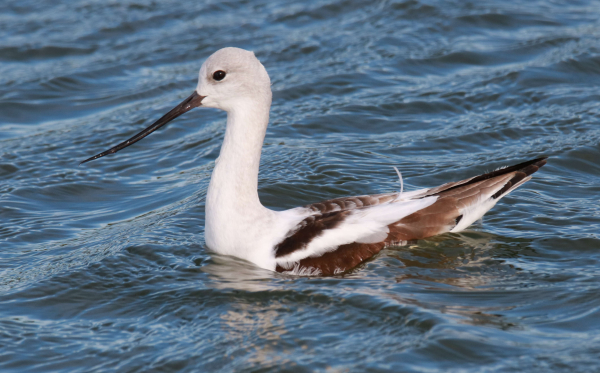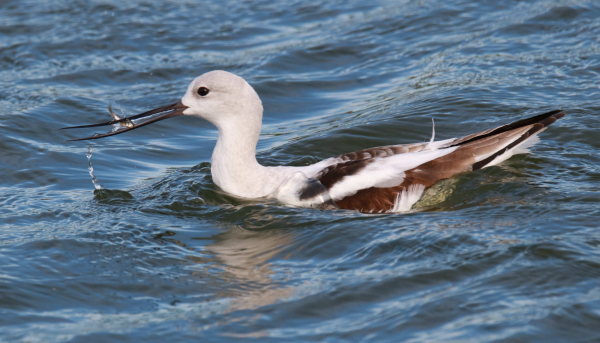That was my thought as I watched an American Avocet picking something out of the shallow water. Well, not that shallow, considering the avocet was swimming rather than wading. But this interesting mega-sandpiper was made to wade and swim, using its webbed feet. The avocet was solo, working the edge of a marsh near the shoreline close to the shoulder of a road – easy access for me in my mobile blind. But was the avocet open to the approach of my big white minivan?
Luckily, it was; although I approached very slowly and carefully with my fingers crossed. The gracefully proportioned pied shorebird was very aware of my approach, but permitted me to park a safe distance away as it resumed feeding.

Now, back to my initial question: What was the American Avocet catching and eating? My initial thoughts included small shrimp, a different swimming invertebrate, maybe an aquatic insect, or perhaps a very small fish. But even with my ultra-good eyesight, and even when using excellent binoculars with the avocet close at hand, whatever tiny animals it was catching and swallowing were very small and partly concealed in its long bill that was ever-moving while grasping and swallowing prey.
Time and time again the avocet dipped into the water, periodically making a successful catch – but what was that little animal it caught? I didn’t fret about actually seeing the food item, but concentrated on taking photos as the avocet raised its bill out of the water, expecting that I would be able to identify the prey in the resulting photographs later when I reviewed the photos of the day. In the meantime, I enjoyed photographing the beautiful avocet in action.

What Was That Bird Eating?
Answering the now compelling question, “what was that bird eating?” was indeed possible and pretty simple when reviewing my still photos a couple hours later. It was catching and eating tiny fish, as illustrated in the second photo accompanying this article. I think minute fish are a more common food than most species descriptions indicate, at least in wetlands a short distance north and south of my office.
When you view the photos illustrating this article, it’s pretty obvious that the colors are vivid; the result of timing my birding session during the best light of the day – now between 3:30 and 6:00pm (I took the photos at the beginning of that time frame, a little after 4pm). The sky was a lush blue color, which is reflected in the color of the water. And the afternoon breeze created some slight wave actions that added another dimension to the water and the foraging action of the avocet.
To get sharp photos of the avocet action – that is, to stop the action while photographing, I would need a fast shutter speed with less concern for a wide area in focus. With the bright sunlight the photos were taken at a shutter speed of 1/800 and an aperture of f7 using an ISO of 400. I tried to anticipate the avocet’s next move, steadied my zoom lens against the open window frame, and held my breath when I pressed the shutter button to increase the chances of taking sharp images.

I get a personal thrill when photographing American Avocets, and the time I spent with this one was a highlight of my Monday. But with the underlying question of “what was it eating” at hand, it was fun to document how to use photography as an aid to answer a simple thought as you are birding, and even to add some insight into a bird’s diet.
To me, bird photography is an essential part of birding – to help you answer simple questions, to aid in species identification, and more. Photographing birds makes you a better birder! But more important, it makes birding more enjoyable – as you are photographing birds, and when you enjoy the images you take thereafter, that night, and during days and years to come. Good luck as you search for the next bird photography opportunities!
Article and photographs by Paul Konrad
Share your bird photos and birding experiences at editorstbw2@gmail.com